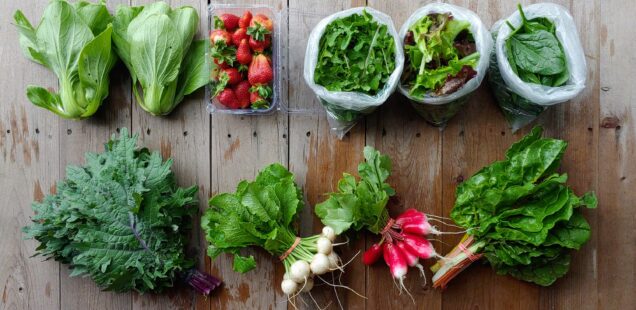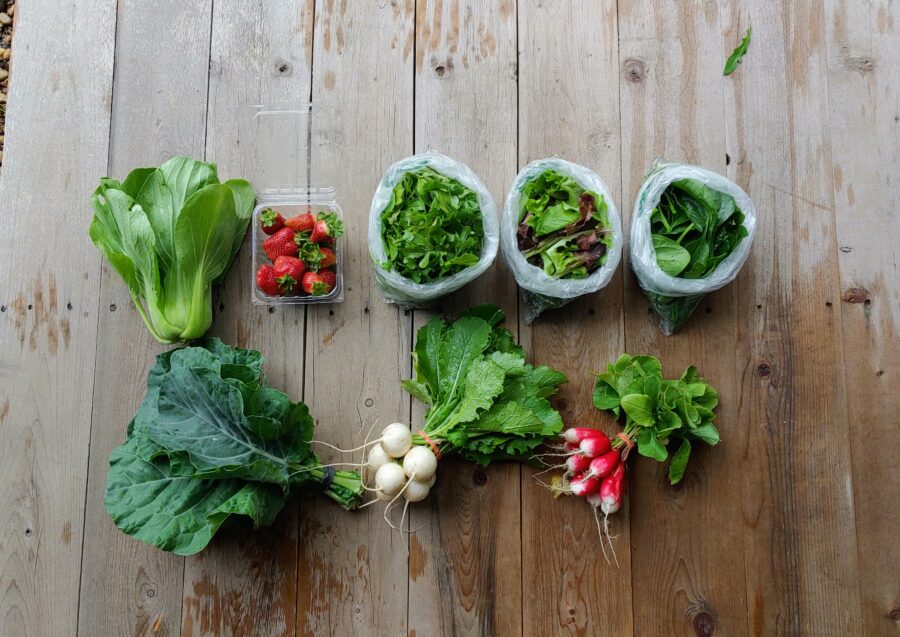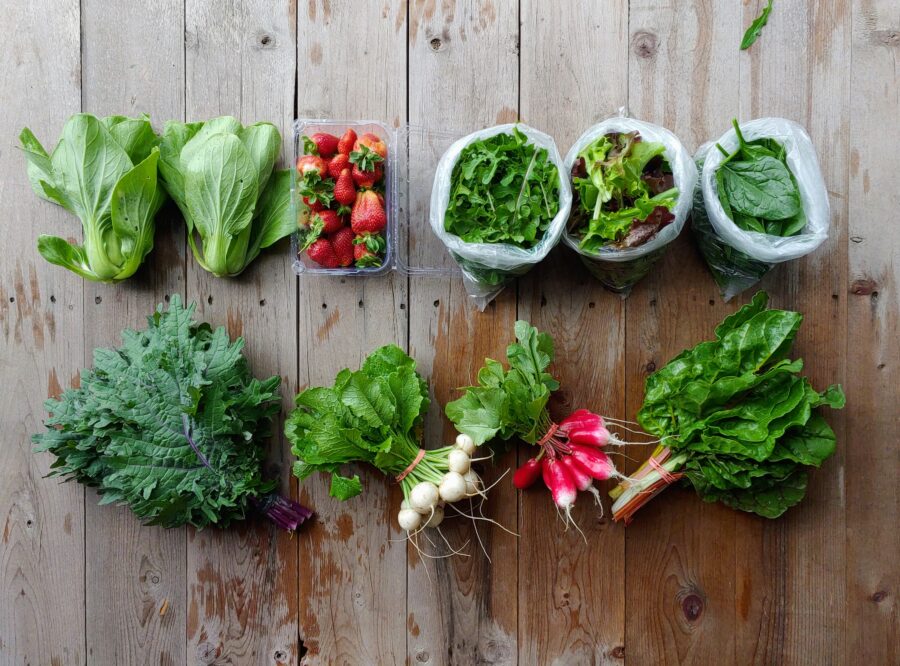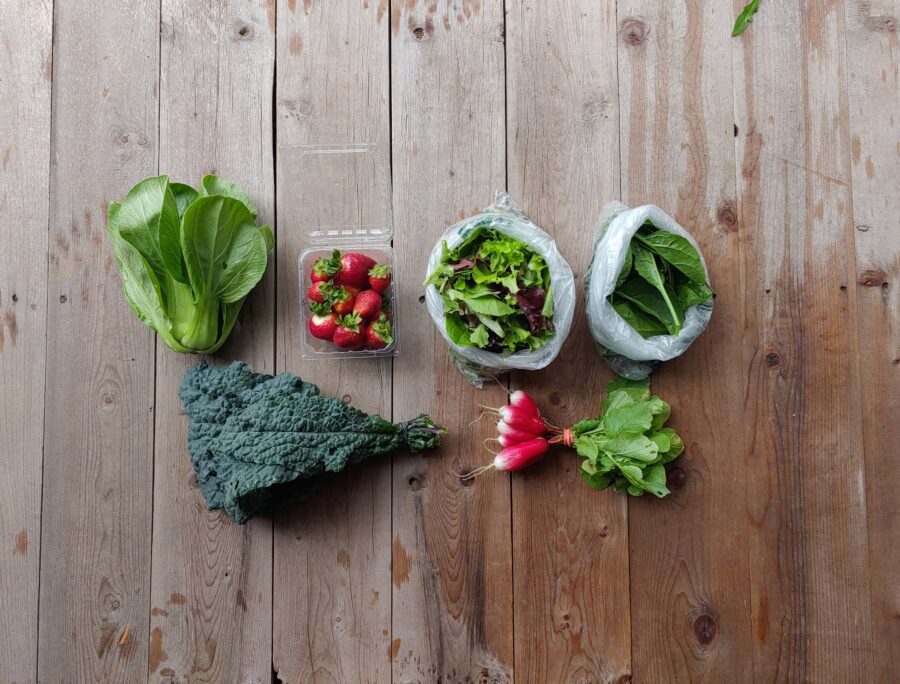
Share Notes April 27, 2023
CSA Share Notes:
Welcome to your very first week of the 2023 Spring CSA! We hope you are as excited as we are about the crops coming your way this season. The weather has yo-yo’d through the winter and early spring, so the crops growth has been unpredictable, but we’re here, ready to start about 1 week later than is typical. There are about 6-9 items in your shares this week, and in weeks to come, ~ 20 additional crops will mature and rotate into your boxes. We’ve included as a very special, first time ever treat: strawberries purchased from a neighboring farm, Golden Hour Farm. Hope you enjoy them!
We harvested in the rain yesterday and boy was it crazy. But we got it done! Whew! If we had had easier harvesting conditions and a bit more labor, we could have harvested 2 more items for you. We’re still hiring more farmhands, with a few interviews this week, so hopefully we’ll have that sorted soon. Notice that some of your items will be quite dirty from the rain splashing up dirt onto the leaves. You’ll have to take a little extra washing time this week. On dry weeks, the crops will be cleaner.
Look back at your emails this week to download our e-book: Tips For CSA Success: A beginner’s guide for CSA members. It’s loaded with all the helpful guidance you need to ensure you love the next 2 months of farm-focused eating.
Here’s this week’s vegetable line up
- Kale — Red Russian kale for the Large shares and Lacinato Kale for the Mini shares. These crops can be used interchangeably in any recipe that calls for kale. Red Russian is often a little more tender, so I prefer it for use in a raw salad. Though the lacinato is also nice raw in a massaged salad. It’s definitely my favorite for soups like minestrone or Portuguese sausage, potato, kale soup. We suggest trying Massaged kale salad, to which you can add any number of delicious toppings like fresh strawberries or blueberries, or mango and avocado, maybe a bit of feta.
- Collard — A bunch of super tender fresh collards for the Regular shares. If you’re not familiar with cooking collards, here’s our best tip: slice up an onion and chop a few cloves of garlic. Add a pinch of red pepper flakes if you’re daring and sauté (in bacon fat, even!) until translucent. Next toss in the shredded or sliced collard leaves and wilt. Cook until as tender as you like them (I prefer mine with a little chew left). You can also sub collards into any Kale recipe with near identical result.
- Chard — Large shares. This colorful crop is eye catching and tastes a whole lot like spinach. I enjoy it in a massaged-greens-salad, or cook it like any of my greens, with an animal fat (butter, ghee, lard, bacon grease) and garlic and onion. The stems are tasty too. The vitamins and minerals in the greens become more bio-available to your body when paired with a good amount of fat. (Isn’t nature genius? And it tastes good too!)
- Spinach — A bag of fresh, iron-rich spinach for everyone.
- Arugula — A bag for all the large shares and most of the regular shares.These leaves are super flavorful and are excellent paired with parmesan cheese, pine nuts, and fresh or dried fruit and a sweet dressing to cut through the peppery arugula bite. Near the end of packing we ran low on Arugula and a few of you received a different item: Spicy Spring Mix, an Asian blend of colorful, frilly leaves, great cooked or mixed into a salad at about 25-50%.
- Lettuce Mix — tender baby lettuce for all!
- Turnip — Large and Regular shares received a nice bunch of our lovely hakurei turnips, a Japanese salad turnip. These are intended to be eaten fresh and raw, sort of like a radish, but the texture is different. They’re a bit nutty and sweet and are the perfect turnip for people who say they don’t like turnips! We’ve got a little write up about them here if you want to read more.
- Radishes — French Breakfast radishes for everyone. These are a wonderful, crunchy heirloom with a very mild spice. Sandwiches, salads, or dip into hummus, or our favorite is to just snack on them sliced thin with sea salt and lemon juice. FYI, radish tops are edible! You can cook them like kale or turnip greens. They tiny hairs come right off when cooked. We had a lot of extra French Breakfast radishes after the farmers market this past weekend, so we made a half-gallon jar of pickled radishes and they are fantastic served atop a slice of buttered sourdough.
- Pac Choi — This Asian cabbage is versatile: fantastic in a stir fry, a ramen or pho, a Thai yellow curry, fried rice, or maybe swap it into Chinese beef and broccoli while we’re awaiting the broccoli to mature. Grab yourself some soy sauce, miso, or curry paste from the international isle and give it a go!
- Strawberries — for everyone! This is a rare treat we wanted to bless you with! This Winter found this lovely little farm north of us near Grand Saline. They began growing berries during the pandemic and are doing a really great job raising beautiful, high-quality, low-input fruits (low input in this instance meaning, they do use select synthetic chemicals in their fruit production, but use them as little as they can to obtain high quality, blemish-free fruit.) The owner and I have chatted several times about production and they have a good grasp on the importance of delay times: spraying many days prior to harvesting to ensure few residues remain on the plants once they arrive in your kitchen. We appreciate their efforts at minimizing their chemical use and we also want to support their efforts at building a healthy, local food economy, and offer assistance to help them reduce chemical use and convert to organic production when open to the idea. Our personal take is, we want to support local farmers, MORE than we want to support organic mega farms in Cali that are mostly growing hydroponically (which in our opinion should be de-facto excluded from organic certification for environmental concerns and chemical use) and are known for labor exploitation. You may have a different take on that, of course, but for any local farms we partner with who are not growing like us, we recommend you wash their produce well prior to consuming. America’s Test Kitchen did a thorough test of which washing methods remove the most pesticides from produce. The findings were in favor of baking soda. It performed higher than water with vinegar, bleach(don’t do this!), peroxide, or soap.
Veggie Storage tips:
Make sure you consult the e-book we sent you this week for a comprehensive veggie storage guide! Most everything will keep longest stored in the fridge sealed up in produce bags. Strawberries will last you 2-3 days so scarf them up soon. All root crops should be severed from their tops to keep the roots from getting rubbery, and the greens stored separately, sealed up to stay fresh. Everything will need a gentle washing before cooking, but leave the dirt on until you’re ready to use them to prevent spoilage.
We’d love to hear stories and recipes of your culinary adventures this week. Send us a note or post a comment of how you’ve used your CSA share.
Your farmers, Jess & Justin


